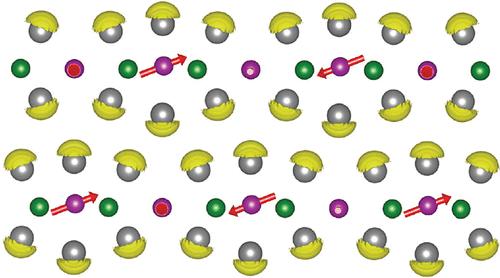当前位置:
X-MOL 学术
›
Chem. Mater.
›
论文详情
Our official English website, www.x-mol.net, welcomes your
feedback! (Note: you will need to create a separate account there.)
MnRhBi3: A Cleavable Antiferromagnetic Metal
Chemistry of Materials ( IF 7.2 ) Pub Date : 2024-11-06 , DOI: 10.1021/acs.chemmater.4c02671 Eleanor M. Clements, Dmitry Ovchinnikov, Parul R. Raghuvanshi, Valentino R. Cooper, Satoshi Okamoto, Andrew D. Christianson, Joseph A. M. Paddison, Brenden R. Ortiz, Stuart Calder, Andrew F. May, Xiaodong Xu, Jiaqiang Yan, Michael A. McGuire
Chemistry of Materials ( IF 7.2 ) Pub Date : 2024-11-06 , DOI: 10.1021/acs.chemmater.4c02671 Eleanor M. Clements, Dmitry Ovchinnikov, Parul R. Raghuvanshi, Valentino R. Cooper, Satoshi Okamoto, Andrew D. Christianson, Joseph A. M. Paddison, Brenden R. Ortiz, Stuart Calder, Andrew F. May, Xiaodong Xu, Jiaqiang Yan, Michael A. McGuire

|
Cleavable metallic antiferromagnets may be of use for low-dissipation spintronic devices; however, few are currently known. Here we present orthorhombic MnRhBi3 as one such compound and present a thorough study of its physical properties. Exfoliation is demonstrated experimentally, and the cleavage energy and electronic structure are examined by density functional theory calculations. It is concluded that MnRhBi3 is a van der Waals-layered material that cleaves easily between neighboring Bi layers and that the Bi atoms have lone pairs extending into the van der Waals gaps. A series of four phase transitions are observed below room temperature, and neutron diffraction shows that at least two of the transitions involve the formation of antiferromagnetic order. Anomalous thermal expansion points to a crystallographic phase transition and/or strong magnetoelastic coupling. This work reveals a complex phase evolution in MnRhBi3 and establishes this cleavable antiferromagnetic metal as an interesting material for studying the interplay of structure, magnetism, and transport in the bulk and ultrathin limits, as well as the role of lone pair electrons in interface chemistry and proximity effects in van der Waals heterostructures.
中文翻译:

MnRhBi3:一种可解理的反铁磁金属
可劈裂金属反铁磁体可用于低耗散自旋电子器件;然而,目前已知的很少。在这里,我们将正交 MnRhBi3 作为一种这样的化合物,并对其物理性质进行了深入研究。通过实验证明剥离,并通过密度泛函理论计算检查解理能和电子结构。得出的结论是,MnRhBi3 是一种范德华层状材料,很容易在相邻的 Bi 层之间裂解,并且 Bi 原子具有延伸到范德华间隙中的孤对电子。在室温下观察到一系列的四个相变,中子衍射表明至少两个相变涉及反铁磁有序的形成。异常的热膨胀指向晶体相变和/或强磁弹性耦合。这项工作揭示了 MnRhBi3 中复杂的相演变,并确定了这种可裂解的反铁磁性金属作为一种有趣的材料,用于研究体和超薄极限中结构、磁性和传输的相互作用,以及孤对电子在界面化学中的作用和范德华异质结构中的邻近效应。
更新日期:2024-11-06
中文翻译:

MnRhBi3:一种可解理的反铁磁金属
可劈裂金属反铁磁体可用于低耗散自旋电子器件;然而,目前已知的很少。在这里,我们将正交 MnRhBi3 作为一种这样的化合物,并对其物理性质进行了深入研究。通过实验证明剥离,并通过密度泛函理论计算检查解理能和电子结构。得出的结论是,MnRhBi3 是一种范德华层状材料,很容易在相邻的 Bi 层之间裂解,并且 Bi 原子具有延伸到范德华间隙中的孤对电子。在室温下观察到一系列的四个相变,中子衍射表明至少两个相变涉及反铁磁有序的形成。异常的热膨胀指向晶体相变和/或强磁弹性耦合。这项工作揭示了 MnRhBi3 中复杂的相演变,并确定了这种可裂解的反铁磁性金属作为一种有趣的材料,用于研究体和超薄极限中结构、磁性和传输的相互作用,以及孤对电子在界面化学中的作用和范德华异质结构中的邻近效应。


















































 京公网安备 11010802027423号
京公网安备 11010802027423号